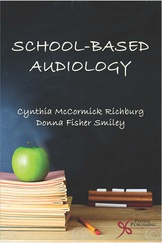Publication
School-Based Audiology
- Details:
- 288 pages, Illustrated (B/W), Softcover, 7 x 10"
- ISBN13:
- 978-1-59756-385-7
- Release Date:
- 10/28/2011
Overview
Written principally with the AuD student in mind, School-Based Audiology takes the reader through the history of audiology in the schools, focusing on legislation that has shaped the face of school-based audiology as it is practiced throughout the United States. Core concepts involving academic achievement in students who are deaf/hard-of-hearing, classroom acoustics, hearing screening programs, hearing loss prevention programs, diagnostic evaluation protocols, hearing aid and FM system verification procedures, and classroom amplification are covered throughout the chapters. Concepts regarding collaboration with other school-based professionals and classroom accommodations and modifications are outlined and provide examples for real-life application.
Each chapter of this textbook concludes with a list of vocabulary words and terms used in the educational environment. Practice management concepts not typically discussed in textbooks on this topic are presented, including minimum competencies, third-party billing, program outcome evaluation, mentoring, and preceptoring. Recently qualified and even seasoned audiologists will appreciate attention given to recent advances in areas like cochlear implants, auditory processing disorders, and auditory dys-synchrony as they relate to managing students with hearing loss.
The varied and ever-changing roles of audiologists in the educational setting are described and highlighted with vignettes, or short personal statements describing real practitioners degree and training information, work settings, job description within their school districts, and day-to-day responsibilities. These personal accounts allow the AuD student an inside look at what audiologists do in the schools. Students are able to experience through these readings how different, exciting, and even challenging school-based positions can be.
Instructors using this textbook will be able to supplement their lectures with the information described here, and will appreciate the structured approach wherein concepts contained in the chapters progressively advance in tune with the readers knowledge. Instructors goals will be met, as well as KASA requirements, because this textbook provides students the necessary knowledge needed to serve in an educational audiology position.
Review
Helen Martin, BA, MSc, MBA, Consultant Clinical Scientist, Audiology, South Tees Hospitals NHS Foundation Trust, Middlesborough, UK, ENT & Audiology News (March/April 2014):
"The text is aimed at AuD students. I found it easy to read and not at all intellectually demanding. If considering a role as a school-based audiologist, I would buy a copy of this book."
CONTENTS
Foreword by Cheryl DeConde Johnson
Contributors
SECTION ONE: FOUNDATIONS
1- The History of Audiology in the Schools
Cynthia M. Richburg and Donna F. Smiley
2- Classroom Acoustics
Donna F. Smiley and Cynthia M. Richburg
3- School-Age Language and Classroom Success
Dee M. Lance and Brenda L. Beverly
4- The Role of the School-Based Audiologist
Cynthia M. Richburg and Donna F. Smiley
SECTION TWO: SERVICES IN THE SCHOOLS
5- Hearing Screening in the Schools
Cynthia M. Richburg, Jackie M. Davie, and Donna F. Smiley
6- Amplification for the Classroom
Donna F. Smiley and Cynthia M. Richburg
7- The School-Based Audiologist and Hearing Loss Prevention/Hearing Conservation Programs
Cynthia M. Richburg and Donna F. Smiley
SECTION THREE: MANAGEMENT
8- Classroom Management
Natalie J. Benafield and Donna F. Smiley
9- Program Management
Donna F. Smiley, Cynthia M. Richburg, and Susan J. Brannen
SECTION FOUR: ADDITIONAL ASPECTS OF SCHOOL-BASED AUDIOLOGY
10- Collaboration with Other School-Based Professionals
Cynthia M. Richburg and Donna F. Smiley
11- School-Based Audiology in Schools for the Deaf
Kathryn Tonkovich, Cynthia M. Richburg, and Donna F. Smiley
12- Cochlear Implants in the Classroom
Erin C. Schafer and Jace Wolfe
13- Auditory Processing Disorders in the School-Aged Population
Jeffrey Weihing and Frank E. Musiek
SECTION FIVE: FUTURE DIRECTIONS
14- School-Based Audiology in the Future
Donna F. Smiley and Cynthia M. Richburg
Index
About The Authors
Cynthia McCormick Richburg, PhD, CCC-A is an Associate Professor in the Special Education and Clinical Services Department at Indiana University of Pennsylvania.
Donna Fisher Smiley, PhD, CCC-A is an audiologist and coordinator for the Educational Audiology/Speech Pathology Resources for Schools (EARS) Program at Arkansas Childrens Hospital. Dr. Smiley has practiced audiology in the areas of pediatrics and school-based audiology for over 25 years. She is a former editor of the Journal of Educational Audiology (2006-2008) and served on the Board of Directors for the American Speech-Language-Hearing Association as the Vice-President for Audiology Practice (2013-2015). In 2018, she was named a Fellow of ASHA. Dr. Smiley received a Bachelor of Science degree in Communication Disorders from Henderson State University, a Master of Science degree in Audiology from the University of Arkansas for Medical Sciences, and a Ph.D. in Hearing Science from the University of Tennessee Knoxville.
Related Titles
A Practical Guide to Quality Interaction with Children Who Have a Hearing Loss
Morag Clark
Foreword by: James W. Hall III
147 pages, Illustrated (B/W), Softcover, 6 x 9"
Speech Development Guide for Children with Hearing Loss
167 pages, Illustrated (B/W), Softcover, 8.5 x 11"
Early Development of Children with Hearing Loss
359 pages, Illustrated (B/W), Softcover, 7 x 10"
School Professionals Working with Children with Cochlear Implants
Patricia M. Chute, Mary Ellen Nevins
239 pages, Illustrated (B/W), Softcover, 6 x 9"











